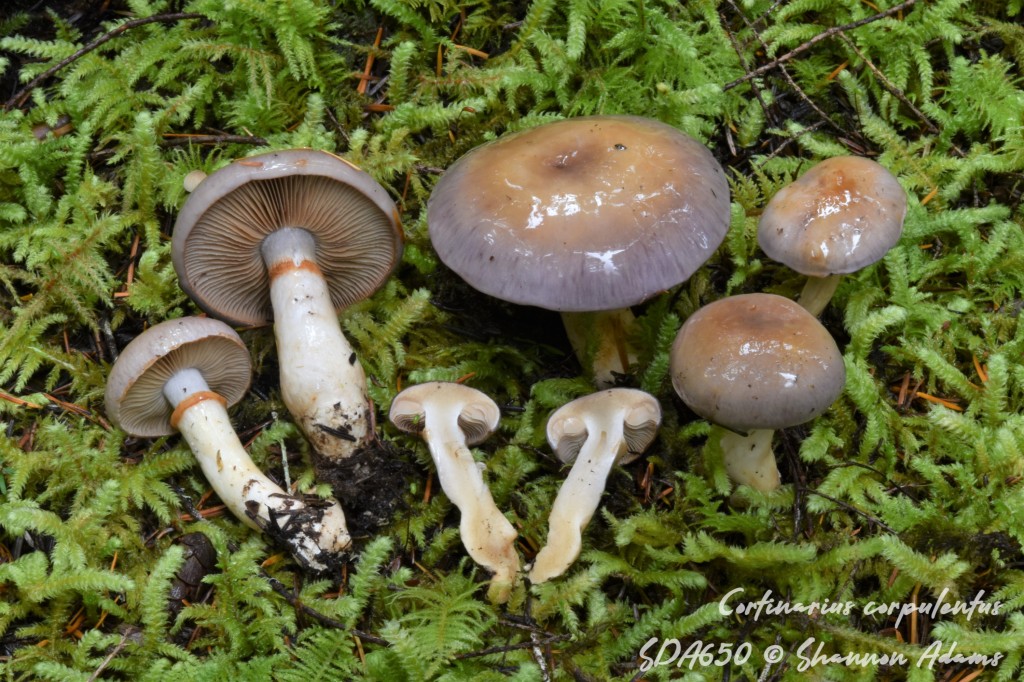Cortinarius corpulentus Bojantchev, S.D. Adams, Liimat. & Niskanen
Publication: IF 901399 – No 565



Diagnosis:
Based on description from Index Fungorum 556 by Dimitar Bojantchev.
Pileus 40–130 mm diam., hemispherical to convex when young, plano-convex to planoconcave in age margin involute, pale blue to lilac, becoming golden-tan to brown on disc with pale lilac blue on margin, copiously glutinous when wet. Lamellae crowded, pale bluish at first then tan, turning brown as the spores mature, lighter bluish near the margin. Stipe 50–130 mm long, 15–75 mm wide, subclavate, very variable in stature, occasionally bulbous, white, very glutinous when wet. Universal veil whitish to pale lilac. Partial veil white at first, leaving a slight to moderate cortina on the stipe, sometimes membranous, sheathing. Context white to pale bluish. Odor earthy. Taste mild. KOH negative. Spores: (7·0–) 7·5–8·0 (–9·5) × (5·0–) 5·5–6·0 (–6·5) µm (mean 7·9 × 6·2 µm), Qav = 1·3, subglobose, moderately verrucose. Basidia 25–35 × 6–10 µm, 4-spored, cylindro-clavate, clamped. Lamella edges sparsely fertile. Cystidia not observed. Pileipellis a thick epicutis, composed of parallel to interwoven hyphae, 6–14 µm wide, Clamp connections common in all parts.
Etymology: (Latin) corpulentus (adjective) meaning plump, corpulent.
Ecology and distribution: the species has a broad distribution along the Pacific Coast of North America, from Washington to California. It has been collected from diverse conifer stands, commonly associated with Pseudotsuga menziesii, but is likely associated with other conifer hosts as well.
Discussion
Cortinarius corpulentus is in section Delibuti. This section has several species in our region that have yet to be fully clarified. A commonly observed related species is Cortinarius salor s.l., which is significantly smaller and has a more slendor stature overall. By contrast, while the fruitbodies of Cortinarius corpulentus range in size, most tend to be large and stout. A key feature of species in section Delibuti is the glutinous stipe and pileus. Its distinct coloration of cap makes it one of the easier species to identify in the field. You may want to differentiate from Cortinarius oregonensis which has a similarly golden-brown disc and can have a lilac margin. However, it does not have a viscid stipe and tends to be more slender in stature, with pale cap.
Phylogenetics:
Holotype UC 2060211
The closest European relative is Cortinarius delibutus s.s. from which differs it by more than 15 base pairs.
Collections examined in type description: USA. California, Yuba County, New Bullard’s Bar Reservoir, Elev. 2200ft., under Notholithocarpus densiflorus, Pinus ponderosa (Holotype UC 2060211; DBB49315, GenBank: OP874939, iNaturalist: 188426072), 10 Dec. 2011; Humboldt County, near Arcata: 2010/11/20, DBB39430 (Genbank: OP874937) 24 Nov. 2013, DBB64695 (Genbank: OP874941) 2019/10/25, SDA158 (Genbank: OR763335); Marin County, Bolinas Ridge: 8 Jan. 2016, DBBMO227375 (Genbank: OP874938); San Mateo County, San Francisco Watershed, 9 Dec. 2014, DBB75018 (Genbank: OP874940); Washington, Pierce County, Soda Springs CG, 25 Oct. 2019, SDA650 (Genbank: OR763334) NS3305 (Genbank: OR763336).

Leave a comment